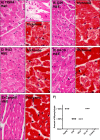Severity and properties of cardiac damage caused by Streptococcus pneumoniae are strain dependent
- PMID: 30216364
- PMCID: PMC6138390
- DOI: 10.1371/journal.pone.0204032
Severity and properties of cardiac damage caused by Streptococcus pneumoniae are strain dependent
Abstract
Streptococcus pneumoniae is an opportunistic Gram-positive pathogen that can cause invasive disease. Recent studies have shown that S. pneumoniae is able to invade the myocardium and kill cardiomyocytes, with one-in-five adults hospitalized for pneumococcal pneumonia having a pneumonia-associated adverse cardiac event. Furthermore, clinical reports have shown up to a 10-year increased risk of adverse cardiac events in patients formerly hospitalized for pneumococcal bacteremia. In this study, we investigated the ability of nine S. pneumoniae clinical isolates, representing eight unique serotypes, to cause cardiac damage in a mouse model of invasive disease. Following intraperitoneal challenge of C57BL/6 mice, four of these strains (D39, WU2, TIGR4, and 6A-10) caused high-grade bacteremia, while CDC7F:2617-97 and AMQ16 caused mid- and low-grade bacteremia, respectively. Three strains did not cause any discernible disease. Of note, only the strains capable of high-grade bacteremia caused cardiac damage, as inferred by serum levels of cardiac troponin-I. This link between bacteremia and heart damage was further corroborated by Hematoxylin & Eosin and Trichrome staining which showed cardiac cytotoxicity only in D39, WU2, TIGR4, and 6A-10 infected mice. Finally, hearts infected with these strains showed varying histopathological characteristics, such as differential lesion formation and myocytolysis, suggesting that the mechanism of heart damage varied between strains.
Conflict of interest statement
The authors have declared that no competing interests exist.
Figures



References
Publication types
MeSH terms
Substances
Grants and funding
LinkOut - more resources
Full Text Sources
Other Literature Sources
Medical
Research Materials

